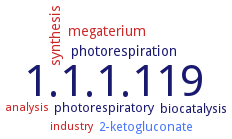1.1.1.119: glucose 1-dehydrogenase (NADP+)
This is an abbreviated version!
For detailed information about glucose 1-dehydrogenase (NADP+), go to the full flat file.

Word Map on EC 1.1.1.119 
-
1.1.1.119
-
photorespiration
-
megaterium
-
synthesis
-
photorespiratory
-
2-ketogluconate
-
biocatalysis
-
analysis
-
industry
- 1.1.1.119
-
photorespiration
- megaterium
- synthesis
-
photorespiratory
- 2-ketogluconate
-
biocatalysis
- analysis
- industry
Reaction
Synonyms
beta-D-glucose: NAD(P) 1-oxidoreductase, dehydrogenase, glucose (nicotinamide adenine dinucleotide phosphate), GDH, GlcDH, GlcDH 2, glucose dehydrogenase, glucose-1-dehydrogenase, glucose-1-DH, halophilic glucose dehydrogenase, Hm GDH, NAD(P)+ glucose dehydrogenase, NAD(P)-dependent GDH, NADP-dependent glucose dehydrogenase, NADP-glucose-1-dehydrogenase, NADP-linked aldohexose dehydrogenase, nicotinamide adenine dinucleotide (phosphate)-dependent glucose-1-dehydrogenase, nicotinamide adenine dinucleotide phosphate-linked aldohexose dehydrogenase, STK_17040
ECTree
Advanced search results
Engineering
Engineering on EC 1.1.1.119 - glucose 1-dehydrogenase (NADP+)
Please wait a moment until all data is loaded. This message will disappear when all data is loaded.
D172K
-
mutation in surface residue, mutant protein is slightly less halotolerant than wild-type
D172K/D216K/D344K
-
mutation in surface residue, mutant protein is slightly less halotolerant than wild-type
D216K
-
mutation in surface residue, mutant protein is slightly less halotolerant than wild-type
D344K
-
mutation in surface residue, mutant protein is slightly less halotolerant than wild-type
D38C
crystallization of a range of binary and ternary complexes of the wild-type and a D38C mutant protein
G206D
G206D/R207I
G206D/R207I/R208N
R207I
D38C
-
crystallization of a range of binary and ternary complexes of the wild-type and a D38C mutant protein
-
I189V
the mutant has decreased kcat and kcat/Km values at both 25°C and 80°C compared to the wild type enzyme
V254I
additional information
less efficient with NADP+ than the wild type, 1.6fold increase in ratio kcat/Km for NAD+
G206D
the mutant is less efficient with NADP+ than the wild type enzyme, the relation kcat/KNAD+ is 1.6times higher than in the wild type, resulting in an enzyme that prefers NAD+ over NADP+
G206D/R207I
no activity with NADP+, highest reaction rate with cofactor NAD+ of all mutants tested
G206D/R207I
the mutant shows no activity with NADP+, when the coenzyme NAD+ is incubated with this double mutant, it reaches the highest kcat value, between 1.5 and 2times higher than the kcat of the wild type enzyme with NADP+, and between 3 and 4times higher than the kcat of the wild type with NAD+
less efficient with NAD+ or NADP+ than the wild-type enzyme
R207I
the mutant is less efficient with NADP+ than the wild type enzyme, shows an increase of 48times in Km value with NADP+ when compared with the wild type accompanied by a decrease in kcat, which clearly makes the R207I mutant less efficient in catalysis with NADP+, the R207I substitution also makes the enzyme less efficient with NAD+, with a decrease of 4 times in kcat/Km, this substitution also increases the Km for glucose
mutant has improved kcat and kcat/Km values at both 25°C and 80°C. The thermal stability of the mutant enzyme was comparable to that of the wild-type enzyme. Calculation of the energetic contribution of the V254I mutation for the dehydrogenase reaction reveals that the mutation destabilizes the enzyme-NADPD-glucose ternary complex and reduces the transition-state energy, thus enhancing catalysis
V254I
the mutant has improved kcat and kcat/Km values at both 25°C and 80°C compared to the wild type enzyme
V254I
-
mutant has improved kcat and kcat/Km values at both 25°C and 80°C. The thermal stability of the mutant enzyme was comparable to that of the wild-type enzyme. Calculation of the energetic contribution of the V254I mutation for the dehydrogenase reaction reveals that the mutation destabilizes the enzyme-NADPD-glucose ternary complex and reduces the transition-state energy, thus enhancing catalysis
-
-
Escherichia coli strain expressing both recombinant glucose 1-dehydrogenase and a glucose facilitator for uptake of unphosphorylated glucose shows a nine times higher initial alpha-pinene oxide formation rate corresponding to a sixfold higher yield of 20 mg per g cell dry weight after 1.5 h and to a sevenfold increased alpha-pinene oxide yield in the presence of glucose compared to glucose-free conditions
additional information
-
introduction of both, GLF and GlcDH, in P450-overexpressing Escherichia coli should enable the cell to carry out a straightforward intracellular cofactor regeneration driven by externally added glucose. For the generation of recombinant Escherichia coli strains carrying two plasmids, these are transformed successively. Firstly, pZY507glf is transformed into Escherichia coli BL21 (DE3). Subsequently, competent cells are prepared from a positive transformant, and then pETDUETbm-3qm glcdh is transformed.


 results (
results ( results (
results ( top
top






